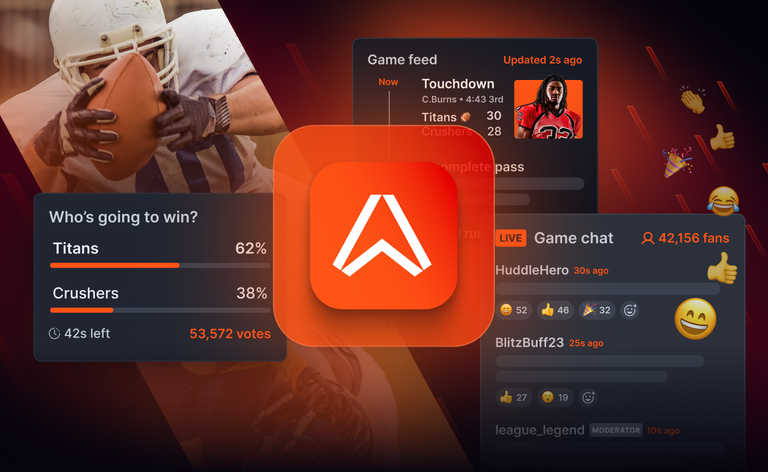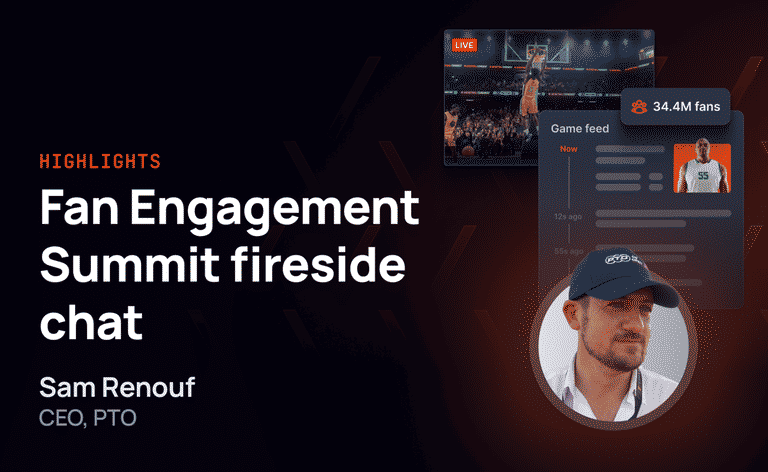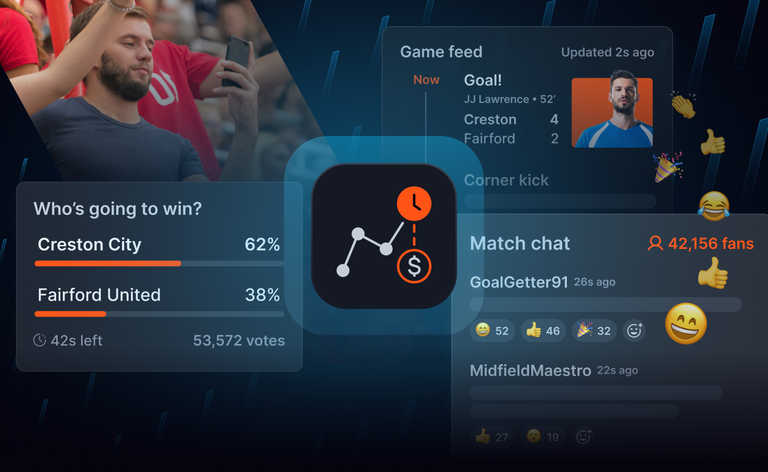Today’s fans are global - often based across the world from their favorite team, sports star, or artist; and they are also virtual - for example, 99% of NBA fans across the world will probably never set foot in an arena. These trends are driving a shift in not only fan behaviors, but also expectations. Fans engaging in live events virtually rely on applications to deliver rich realtime experiences with such low latency and reliability that it can almost replace the in-person experience.
This has placed delivering these globally-available experiences high up on the agenda of fan-centric businesses. But to be successful, companies need to build or buy the right realtime experience technology. In this article, we explore what a modern realtime experience platform looks like, and outline the requirements you should look for when making this critical technology choice.
The requirements of modern realtime experience platforms
Through our work with customers including NASCAR, Genius Sports, Tennis Australia, Stadion, and Sportsbet we have uncovered the four key requirements of a modern realtime experience platform:
- Realtime. All the time.
- Built for scale.
- Designed to maximize ROI
- Provide composable realtime services.
Let’s look at each of these points in turn, including the infrastructure required to support them, and expertise required to deliver on them.
1. Realtime. All the time.
Whether fans are watching the game in the stadium or remotely, they should share the same live experience - wherever they are in the world! This means all data, whether its chat messages or betting odds, has to be delivered at low latency.
The value of low latency when delivering realtime updates can’t be overestimated. Not only does it ensure a good user experience, but also minimizes the risk of incurring liabilities e.g. In-play betting puts a premium on reliable, predictable realtime performance at low latency – if data arrives late, players can bet on events that have already happened, costing operators money and damaging its reputation.

Every user that opens the app needs to be able to get updates that feel instant – even in extreme circumstances. From the perspective of a user expecting realtime updates, latencies need to be 100ms or lower to feel “instantaneous” or “live.” Any slower and the update no longer feels realtime and the promise of the feature fails.
From a platform perspective providing a great realtime experience isn’t simply about minimizing latency. It’s also about minimizing the variance and providing predictability to developers.
When you can work to a low median global latency that will always be within specific operating boundaries it mitigates unfavorable choppy, stuttering realtime experiences with noticeable delays. You can design, build, and scale features around this certainty, confident they’ll perform as expected under various conditions - across the globe.
2. Built for scale
There has been a significant shift in the scale of data over recent years. This is partly down to the record-breaking levels of concurrent viewership that we are starting to see - especially in the likes of Indian cricket where the 2023 men’s final set a streaming record with a peak concurrent audience of 59 million viewers!
This means that modern realtime experience platforms have to be built to handle extreme scale. Especially in the context of fan engagement. This requires their infrastructure to be highly reliable, available - but more specifically, it has to be elastic. Let’s look at how each of these infrastructure requirements relates to realtime fan engagement experiences.

Reliability
The reality of fan experiences is that they are based around ‘spikey’ events - and the reliability of the service at these critical moments is what makes fan engagement experiences work for fans, drive retention, and deliver monetization opportunities.
This means that you need to prepare for your busiest moments - and make sure your infrastructure design treats failure as ‘business as usual’. If you don’t, your customers - and your business - will suffer.
At Ably, we have designed things with the expectation that things will fail - we don’t even rely on AWS to work 100% of the time. Data centers will fail, a fire will happen, a fiber line will get cut - and we will just continue to operate by turning off the impacted data center whilst we investigate the cause.
Availability
Availability is all about ensuring that you have the capacity in the system to absorb the spikes in those magic moments when a goal is scored, or to service the millions of fans who arrive to watch the final set in a tennis match, all whilst maintaining the performance targets of delivering the experience in realtime.
The reality is that when you try to do this yourself there is a constant battle between commercial objectives for operating costs of the system and capacity needed for when it matters most to fans. Fortunately at Ably, we’re now operating at true internet scale (processing trillions of messages to billions of devices), akin to many CDNs, we have the spare global capacity at any time to absorb even the most demanding black swan events with millions of fans.
You can read more about how we deliver reliability and availability at Ably on our Four Pillars of Dependability page.
Elasticity
Elasticity, as the term implies, is the ability for software infrastructure to stretch and shrink in line with fluctuating usage. Elasticity is important in many contexts – because usage can always fluctuate – but it’s especially important for sports, media, and entertainment apps, which frequently serve user bases that grow and shrink rapidly depending on events, trends, and breaking news.
Elasticity is not a new problem for realtime update systems, but the challenge of building adaptable, elastic infrastructure is different in two major ways:
- Elasticity is harder to deliver because realtime updates tend to be resource-intensive and especially in sports, media, and entertainment contexts, the amount of users can fluctuate dramatically if an important event or game is happening.
- Elasticity is also more important to maintain in realtime contexts because the “live” experience that realtime features typically promise is effectively broken if users can’t access updates.
Elasticity also tends to resist simple solutions. Adding new servers, for example, can improve scalability but new servers can make data integrity (reliability and availability) harder to maintain as the cluster scales and rebalances load. And no matter how well you know your users, and the events that could cause a surge, there will always be unforeseen moments and ‘black swan’ events.
This means that although adding capacity manually can be an option, it isn’t a fit for fan experiences. Instead these require an automated approach which allows the system to scale up or down based on user demand and without engineer intervention.
At Ably, we’ve built a realtime experience platform that ensures capacity and availability – allowing developers to maintain levels of scalability and elasticity that meet all of their users’ realtime expectations without compromising on the integrigy of streams, as our cluster routinely dynamically resizes itself.
Realtime isn’t a part time activity, and if you make it one you risk missing out on those high engagement moments that no one can anticipate - whether that’s a goal, a batsman is bowled or a different driver takes the lead. You have to be ready all the time, and have the right infrastructure in place to make this possible.
3. Designed to maximize ROI with considered choices
The other dimension to handling extreme viewerships, is enabling the audience to engage and talk to one another. This creates what is known as the N-Squared problem and potential rapid escalation of costs. Imagine that the average fan posts two messages each hour and, in turn, each post generates ten responses - when you are talking about audience sizes into the 100’s of thousands, then delivering everything to every fan gives us some very large numbers.
As referenced in the section on scalability, the volumes of data being sent, received, and reacted to is ever-growing. And this means that leaving the cost of realtime experiences to grow exponentially will eat into any profits you might get - but in most cases, make realtime fan experiences not economically viable.
Therefore, to make realtime experiences profitable, your technology choice has to offer the flexibility to apply design patterns that can help you to optimize spend. In my recent thought leadership piece, I explored three different design patterns that can be applied to solve the N-Squared problem and arrive at a predictable cost per hour …
- Batching: This is where you deliver groups of messages together rather than sending each message individually.
- Aggregating: This is where you compute what has changed and send only the results rather than the individual updates, reducing the overall amount of data transferred.
- Partitioning: An approach based on segmenting the fanbase into sub-groups, so that messages are delivered to a predictable number of fans rather than to every fan every time.
What is paramount, is understanding how to apply these without compromising the fan experience. For example, whilst one part of your experience might depend on super low latencies, others - for example emoji reactions - could use batching to reduce cost without impacting the user experience. Having a team on board or support through your platform provider to advise on the use of these design patterns can be the difference between an engaging and ROI positive fan experience - and one that fails to be profitable.

4. Offering composable realtime services
A robust realtime platform is essential for delivering engaging and interactive experiences in today's digital landscape. To truly captivate audiences, a platform must offer a diverse set of tools and capabilities. Beyond core features like chat, successful implementations often require a combination of live updates, data broadcasting, collaboration tools, and more.
Relying on specialized, single-purpose platforms can be limiting in this context. To create truly immersive experiences, businesses often find themselves piecing together multiple solutions, leading to increased complexity and costs. Building these capabilities from scratch is even more resource-intensive, diverting focus from core product development. Conversely, a comprehensive realtime platform will offer a suite of products that you can ‘mix and match' enabling the necessary flexibility to innovate and deliver exceptional user experiences.
Delivering modern fan engagement experiences with Ably
As I’ve outlined, there’s a lot that goes into delivering the infrastructure, platform, and design choices to deliver modern fan engagement experiences successfully. Everything that we’ve done, and continue to build at Ably is designed to meet the needs of modern fan experiences - and make them affordable, especially at scale.

We’ve already worked with a number of sports franchises, creators, entertainers, and broadcasters globally - including NASCAR, Genius Sports, Tennis Australia, Stadion, and SRF - to help them deliver reliable, scalable, low-latency fan experiences that provide a healthy return on investment. Made possible through our range of cost optimization features:
- Limitless fan-out: Broadcast updates from one to millions of clients, in milliseconds. Ably absorbs very large and unexpected traffic spikes, with autoscaling systems that actively manage capacity. No need to pre-provision on your part.
- Optimizing costs for extreme concurrent chat and reactions: Our message batching feature is designed to significantly reduce the number of messages the system needs to send. This is essential for optimizing costs and enhancing performance in large-scale, high-throughput applications, particularly critical for live streaming chat.
- Large presence sets and occupancy: Enable a high concurrency of fans in a large chat room to have their online status shared with others in the room and for them to be aware of others present, including total occupancy, at any given point.
- Bandwidth efficient deltas: Benefit from significant bandwidth reduction when broadcasting large data sets using binary delta compression. Only the changes are broadcast.
- Subscription filters: Create personalized data streams for large numbers of individual fans or limit clients’ access to different parts of the data, based on specific criteria - helping reduce costs.
- Data integrity guarantees: Ensure the value of realtime experiences is delivered with our data integrity guarantees. Guaranteed message ordering from any single realtime or non-realtime publisher to all subscribers and exactly-once message delivery guarantees - not repeat deliveries.
- LiveObjects (coming soon): This feature will move the aggregation problem down into the platform and API layer of our stack. It will allow you to compute what’s changed and to only emit the computed change as opposed to the batch of each individual change.
- Partitioning: We are at early stages of developing a partitioning solution and are actively talking to customers now on how best to design that. Please reach out to find out more, we’d welcome further insights.
- Consumption-based pricing that’s billed by the minute: Our pricing model gives you granular control over your costs. You only pay for what you use: messages sent, channels active, and connections made). This means you can budget effectively and avoid surprise charges. Ideal for limiting the costs of peaky high volume traffic surges.
Fundamentally, we want to make sure your success isn’t costly. If you are interested to see how you could benefit from working with Ably, get in touch - or try our platform for free by signing up for an account today.




